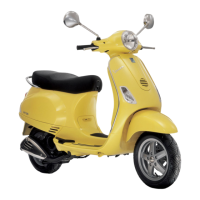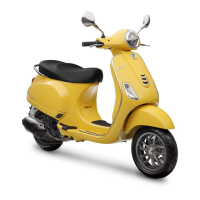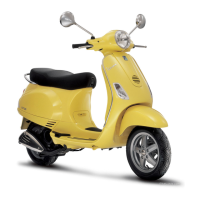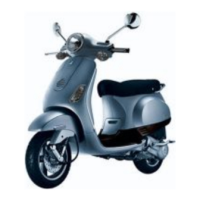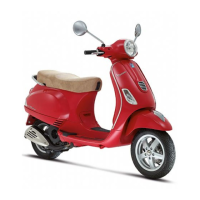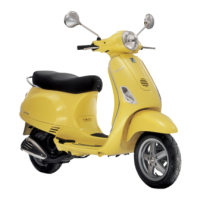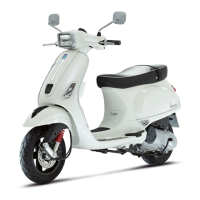
Do you have a question about the Vespa LX 2012 and is the answer not in the manual?
| Engine Type | Single-cylinder, 4-stroke |
|---|---|
| Displacement | 124 cc |
| Cooling System | Air-cooled |
| Fuel System | Carburetor |
| Transmission | Automatic CVT |
| Fuel Tank Capacity | 8.6 liters |
| Seat Height | 785 mm |
| Curb Weight | 114 kg |
| Length | 1, 770 mm |
| Width | 705 mm |
| Height | 1, 140 mm |
| Max Power | 10.3 hp @ 7, 750 rpm |
| Front Suspension | Single arm with coil spring and hydraulic shock absorber |
| Front Brake | 200 mm |
| Rear Suspension | Coil spring and hydraulic shock absorber |
| Rear Brake | 110 mm drum |
Describes the general specifications of the vehicle.
Outlines safety and maintenance guidelines for repair operations.
Provides chassis and engine numbers, including prefixes for LX and S versions.
Details the vehicle's weights and overall dimensions.
Lists specialized tools required for maintenance and repair procedures.
Provides a table of scheduled maintenance tasks and intervals.
Details the procedure for checking and replacing the spark plug.
Explains how to check and replace the rear hub oil.
Describes the procedure for cleaning and replacing the air filter.
Details the process for changing engine oil and replacing the oil filter.
Covers checking ignition timing and valve clearance.
Explains how to check and top-up the brake fluid level.
Details how to adjust the vehicle's headlights.
Addresses poor performance, starting difficulties, and oil consumption/smoke.
Covers issues related to poor lubrication pressure.
Details clutch performance and braking problems.
Addresses steering, suspension noise, and oil leakage.
Troubleshooting for battery problems.
Presents electrical wiring diagrams for LX and S versions.
Shows the location of key electrical components on the vehicle.
Explains the immobiliser system and troubleshooting diagnostic codes.
Covers battery recharge, starting circuits, and checks.
Details stator check and recharge system voltage check.
Details checks for starter motor, starter relay, and horn control.
Covers checks for turn signals, fuel level, and other indicators.
Explains fuse layout, types, and dashboard indicator functions.
Details the procedure for removing the exhaust assembly.
Provides steps for safely removing the engine from the vehicle.
Covers transmission cover removal and drive pulley service.
Details clutch removal, inspection, and pin retaining collar.
Steps for removing and refitting the hub cover and related components.
Covers splitting crankcase halves and inspecting components.
Explains the lubrication system and oil pressure checks.
Covers intake manifold, rocker-arms cover, and timing system drive.
Details on how to remove the camshaft.
Steps for removing the cylinder head.
Procedure for removing valves, cotters, and springs.
Steps to remove the cylinder and piston assembly.
Details refitting piston rings and the cylinder.
Explains the integrated injection and ignition system.
Details the fuel system components and operation.
Describes the ignition system components.
Provides tips for troubleshooting MIU system failures.
Procedure for resetting the throttle valve position sensor.
Covers front wheel and hub overhaul.
Details handlebar removal/refitting and steering column overhaul.
Covers rear wheel removal/refitting and swing-arm overhaul.
Details removal, refitting, and overhaul of the front shock absorber.
Covers removal and refitting of steering bearings.
Details removal and refitting of the front brake caliper.
Covers front brake disc removal, refitting, and inspection.
Procedure for removing and refitting front brake pads.
Explains how to bleed the front brake system fluid.
Details removal and refitting of the front brake pump.
Procedure for servicing the rear drum brake.
Covers removal of rear and front handlebar covers and instrument panel.
Details removal of headlight assembly and knee-guard.
Covers removal of front mudguard and central cover.
Checks for paintwork, plastics, scratches, and dirt.
Checks safety fasteners and fixing screws for proper torque.
Checks battery, lights, switches, and instrument panel.
Checks hydraulic fluid, hub oil, and engine oil levels.
Covers vehicle testing procedures after repair/assembly.
Performs functional checks on braking, clutch, engine, and other systems.


